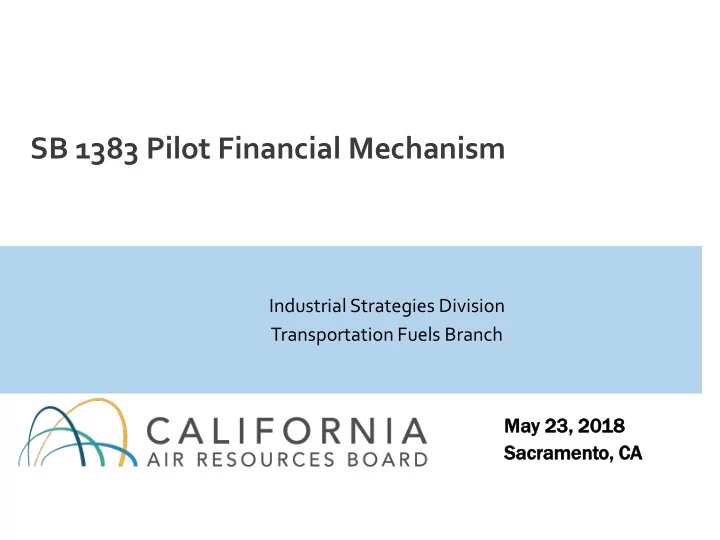

SB 1383 Pilot Financial Mechanism Industrial Strategies Division Transportation Fuels Branch May 2 23, 2 2018 Sac Sacramento, o, CA
Introduction – SB 1383 directs ARB to “develop a pilot financial mechanism to reduce the economic uncertainty associated with the value of environmental credits, including credits pursuant to the Low-Carbon Fuel Standard regulations (Subarticle 7 (commencing with Section 95480) of Title 17 of the California Code of Regulations) from dairy-related projects producing low-carbon transportation fuels.” 2
Agenda – Draft White Paper Released – Brief discussion of potential financial mechanism alternatives – Information/Feedback Needed 3
Draft White Paper – Draft white paper was released this Monday, May 21 st , 2018. – Includes: • Description of the alternative financial mechanisms considered • Current staff thinking on the potential design aspects of the financial mechanism • Staff’s analysis on the funding needed to implement the financial mechanism • Staff’s thoughts on what organizations could run the program – Link to Draft White Paper: https://www.arb.ca.gov/cc/dairy/dsg2/pilot-financial- mechanism-white-paper.pdf 4
Possible Pilot Financial Mechanisms – Two mechanisms are considered: Contracts for Difference and Put Options. – Both mechanisms will reduce the risk of dairy digester projects substantially. – Risk is not eliminated – some risk is transferred to the Program Administrator. 5
Possible Mechanism: Contracts for Difference 1. Contracts for Difference (CfD) : the program administrator ( Administrator ) will guarantee the fuel producer (Producer) a certain value for environmental credits (Strike Price) for a specified period of time (Contract Period). If market prices of the environmental credits (Market • Price) are lower than the Strike Price, the Administrator will pay the Producer the difference. If the Market Price of the environmental credits is higher • than the Strike Price, the Producer will pay the Administrator the difference. 6
Example: Contracts for Difference 250 Total Revenue 200 Contract for Difference Environmental Credit Revenue 150 $ Gain or Loss 100 50 0 0 20 40 60 80 100 120 140 160 180 200 -50 -100 Market Price ($) 7
Possible Mechanism: Put Options 2. Put Option : Similar to a price insurance. the Administrator will guarantee a minimum value for the environmental credits for a specified period of time. The Producer will pay the Administrator the price of the option • ( Premium). Proceeds will be used exclusively to fund the future payments by the mechanism. If the Market Price is lower than the Strike Price, the Administrator • will pay the Producer the difference. If the Market Price of the environmental credits are higher than the • Strike Price, then no money is exchanged . 8
Example: Put Options 250 Put Option Total Revenue 200 Environmental Credit Revenue $ Gain or Loss 150 100 50 0 0 20 40 60 80 100 120 140 160 180 200 Market Price ($) 9
Determination of Strike Price – The Strike Price for both CfD and Put Options could be determined by a reverse auction Number of bids Bidders decide greater than Administrator whether to funding declares initial bid or not available? Strike Price, (for options, YES NO declare fixed premium) New round: Bidders receive the Administrator instrument with lowers offered the last round’s Strike Price Strike Price 10
Determination of Market Price – Current staff thinking is to include the widest definition of project revenues for the market price. • Value of LCFS credits • Value of RFS credits • Value from fuel sale • Any other future environmental credit generated by the sale or use of the fuel 11
Potential Administrators – California State Treasurer: e.g. the California Pollution Control Financing Authority – CEC – CDFA – Independent non-profit organization: e.g. Climate Trust – CARB: not recommended since agency influences prices of LCFS credits, a major revenue components for projects. 12
Information/Feedback Needed – Preferred mechanism – Market price: what values to include (LCFS, RFS, fuel sale?) – Auction mechanics • Will there be enough bidders to make auctions competitive? – Adjustments to contracts for projects which received grants – Additional suggestions on most appropriate administrator 13
Questions/Feedback For questions please contact: Firas Abu-Sneneh Firas.Abu-Sneneh@arb.ca.gov Please send your comments to the Dairy and Livestock Subgroup #2 Comments Docket, which can be found at the bottom of this link: https://www.arb.ca.gov/cc/dairy/dsg2/dsg2.htm 14
Recommend
More recommend